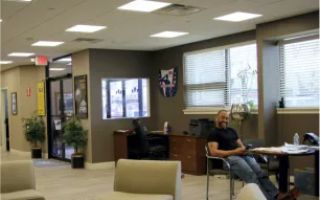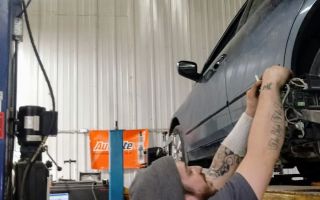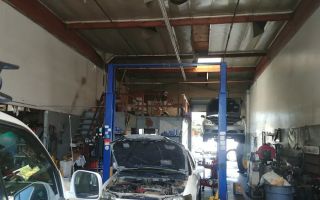Can I Continue Driving After a Flat Tire Repair?
Flat tires are one of the most common car issues drivers face, and they can happen unexpectedly at the worst times. Whether you’ve experienced one yourself or heard about it from others, the question often arises: “Can I continue driving after a flat tire repair?” I’ve been in this situation a few times, and each experience taught me something new about tire safety and repair. In this article, we’ll break down everything you need to know about flat tire repairs, what you should consider after having one, and whether or not it’s safe to drive on a repaired tire.

MR. TIRE INC.
2078 New York Ave, Huntington Station, NY 11746, USA
1. What Happens During a Flat Tire Repair?
When you experience a flat tire, the first instinct is often to pull over and assess the situation. After a proper tire repair, the next question is usually about whether it’s safe to keep driving. To answer that, we need to understand the repair process. When you get a flat tire repaired, the typical methods include patching the hole, using a tire plug, or, in some cases, replacing the tire entirely. Depending on the type of damage and repair method, the question of safety can vary.

MR. TIRE INC.
2078 New York Ave, Huntington Station, NY 11746, USA
1.1 Patching the Tire
When you have a small puncture, like a nail or screw, the tire repair shop may choose to patch it. This involves removing the tire from the wheel, cleaning the area of damage, and applying a rubber patch. This method can be effective, especially when the damage is located on the tread, as long as the tire has not been weakened by other factors, such as age or improper inflation.
1.2 Using a Tire Plug
Another common method is using a tire plug. This temporary fix involves inserting a rubber plug into the hole of the tire. It’s often used when you're in an emergency situation or if the puncture is on the tread area. While a tire plug may work temporarily, it’s essential to monitor the repair, as it’s not a long-term solution and should be checked frequently.
1.3 Replacing the Tire
If the tire has significant damage, such as sidewall damage, or if the repair would compromise the integrity of the tire, replacing it is the best option. In some cases, when the tire cannot be safely repaired, a new tire is the only solution. Replacing a tire is the most reliable way to ensure your vehicle's safety on the road.
2. Can You Continue Driving on a Repaired Tire?
The answer to whether you can continue driving on a repaired tire depends on a few factors. If your tire was patched or plugged correctly, and the repair is sound, it is generally safe to drive. However, it’s essential to understand the limitations of the repair. Here are a few things to consider:
2.1 The Extent of the Damage
The extent of the damage plays a crucial role in determining whether it’s safe to drive after a flat tire repair. If the puncture was minor and the tire was repaired properly, you can drive it safely for a while. But if the damage was severe or located on the sidewall, the tire may be compromised even after the repair, which could lead to future issues. I’ve driven on a repaired tire after a minor puncture, but I made sure to take it easy on the road, avoiding high speeds and sharp turns.
2.2 The Repair Quality
The quality of the repair is essential. I once had a tire repaired at a shop that did a poor job of sealing the puncture, and within a few days, the tire started losing air again. After that experience, I learned to check if the repair is done properly and even monitor the tire pressure regularly after a flat tire repair. If you’re not sure about the quality of the repair, it’s worth getting a second opinion from another shop.
2.3 Monitoring the Tire
Even if your tire has been properly repaired, it’s important to keep an eye on it. The last thing you want is to be stranded on the side of the road with another flat. I always make sure to inspect the tire frequently, check the air pressure, and watch for any signs of irregular wear after a flat tire repair. If you notice the tire deflating, it might indicate that the repair wasn’t effective or that the tire is no longer safe for use.
3. What Should You Do if You’re Unsure About Your Repair?
If you’re unsure about the quality of your flat tire repair, or if you’re feeling uneasy about continuing your drive, there are a few steps you can take to be cautious:
3.1 Get a Professional Inspection
Sometimes, it’s best to have a professional mechanic take a look at your tire after a repair. They can ensure that the fix is solid and that the tire is safe for continued driving. I once had a tire that I was unsure about after a plug repair, so I took it to a shop for a thorough inspection. The technician was able to confirm that the tire was fine and gave me peace of mind to continue my trip.
3.2 Use a Spare Tire
If you’re uncertain about the repair, the safest option is to install a spare tire. It may take some time and effort, but it’s far better than risking a blowout on the highway. I always keep a spare tire in my trunk, and I recommend that every driver do the same. If you’re far from home or in a remote area, you can always use your spare to get to a safer location where a more thorough inspection can be done.
3.3 Contact Roadside Assistance
If you find yourself stranded after a flat tire and are unsure whether you can safely continue driving, it’s a good idea to contact a roadside assistance service. Many insurance policies offer roadside assistance, and services like Rescue & Towing can help you with tire changes, towing, and other emergency services. I’ve used their services before, and having that kind of backup support can make all the difference during stressful situations.
4. Preventing Future Flat Tires
While a flat tire can be unavoidable, there are steps you can take to reduce the chances of it happening in the future. I’ve learned a few key things from my own experience:
4.1 Regular Tire Maintenance
One of the most important aspects of preventing flat tires is regular maintenance. This includes keeping your tires properly inflated, checking for signs of damage, and rotating them regularly. By maintaining your tires, you can extend their lifespan and reduce the risk of sudden blowouts.
4.2 Avoiding Road Hazards
Avoiding road hazards is another way to reduce the chances of getting a flat tire. Always be mindful of debris on the road, such as nails, glass, or sharp objects. I’ve made it a habit to drive cautiously around construction zones or places where debris may be present.
4.3 Keep an Emergency Kit in Your Car
Having an emergency kit with tire repair tools, a jack, and a spare tire can be a lifesaver. I always carry an emergency kit in my car, which has helped me on more than one occasion. It ensures that I’m prepared for any situation and can handle a flat tire efficiently.
5. Conclusion
So, can you continue driving after a flat tire repair? The answer depends on several factors, including the quality of the repair and the condition of the tire. If your tire has been repaired properly, it’s generally safe to continue driving. However, if you’re unsure, don’t hesitate to get it checked or opt for a spare. The key is to always stay vigilant about tire safety and to be prepared in case of an emergency. Don’t risk your safety by ignoring potential issues—take the necessary steps to ensure that your tires are in good condition.
If you find yourself in a situation where you're unsure about your tire repair or need assistance, remember that professional services like Rescue & Towing are there to help you. Don’t hesitate to contact them for all your roadside emergency needs.























